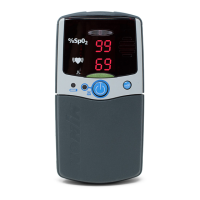How to fix a Nonin PalmSAT 2500A VET that will not turn on?
- JJacob RodriguezAug 18, 2025
If your Nonin Pet Care Product won't turn on, the batteries may be depleted or installed incorrectly, or there may be damage to the metal contact in the battery compartment. First, replace all 4 batteries. If that doesn't work, verify the correct battery orientations. If the issue still persists, contact Nonin Technical Service.

